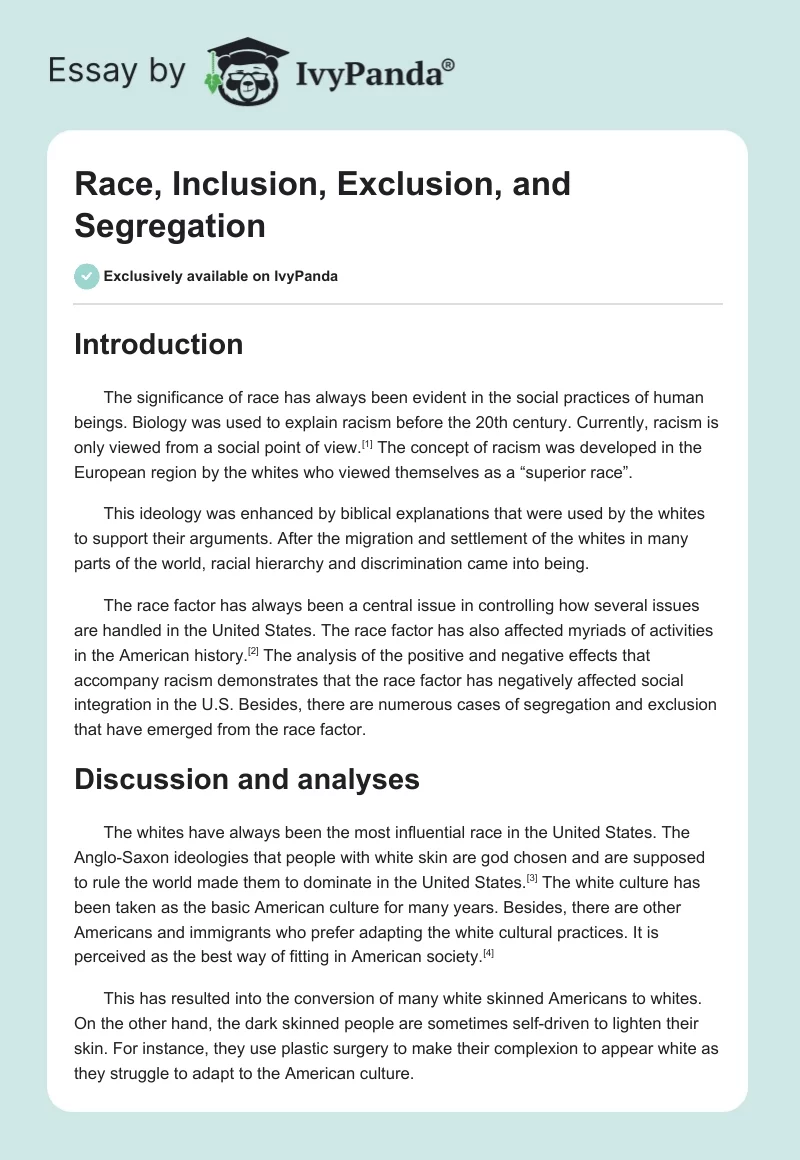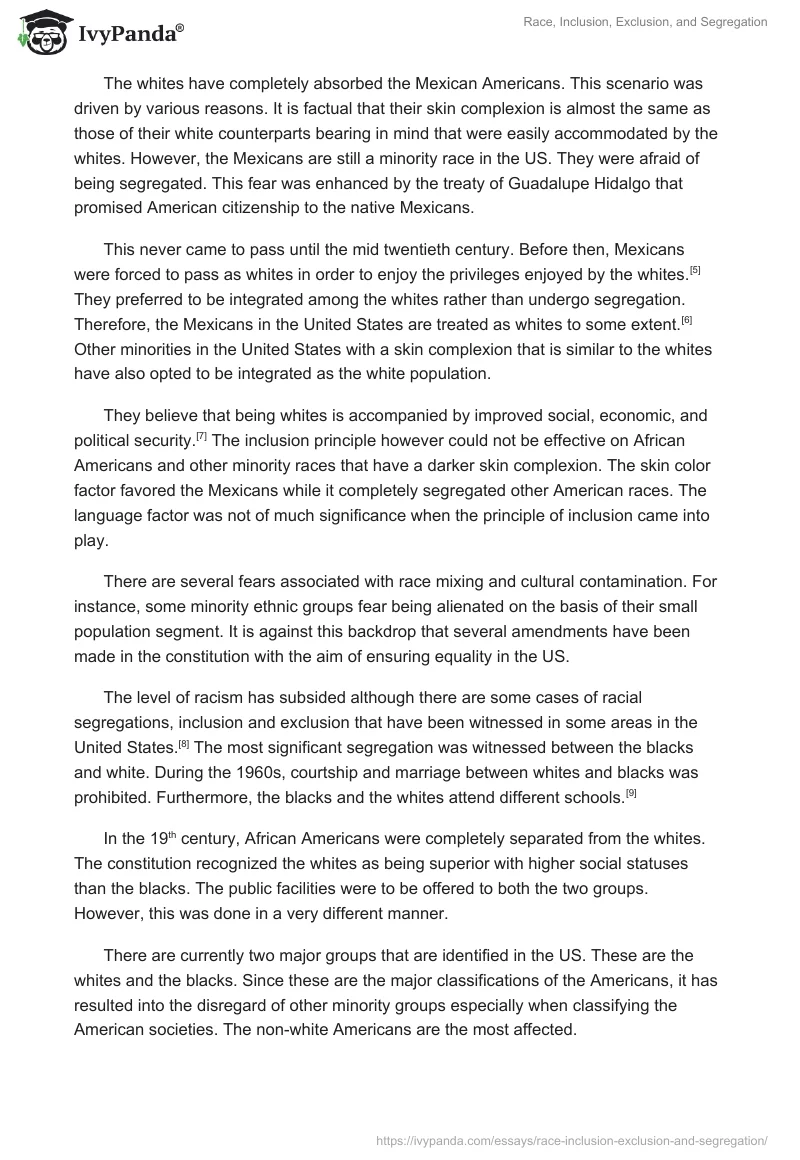Introduction
The significance of race has always been evident in the social practices of human beings. Biology was used to explain racism before the 20th century. Currently, racism is only viewed from a social point of view. The concept of racism was developed in the European region by the whites who viewed themselves as a “superior race”.
This ideology was enhanced by biblical explanations that were used by the whites to support their arguments. After the migration and settlement of the whites in many parts of the world, racial hierarchy and discrimination came into being.
The race factor has always been a central issue in controlling how several issues are handled in the United States. The race factor has also affected myriads of activities in the American history. The analysis of the positive and negative effects that accompany racism demonstrates that the race factor has negatively affected social integration in the U.S. Besides, there are numerous cases of segregation and exclusion that have emerged from the race factor.
Discussion and analyses
The whites have always been the most influential race in the United States. The Anglo-Saxon ideologies that people with white skin are god chosen and are supposed to rule the world made them to dominate in the United States. The white culture has been taken as the basic American culture for many years. Besides, there are other Americans and immigrants who prefer adapting the white cultural practices. It is perceived as the best way of fitting in American society.
This has resulted into the conversion of many white skinned Americans to whites. On the other hand, the dark skinned people are sometimes self-driven to lighten their skin. For instance, they use plastic surgery to make their complexion to appear white as they struggle to adapt to the American culture.
The whites have completely absorbed the Mexican Americans. This scenario was driven by various reasons. It is factual that their skin complexion is almost the same as those of their white counterparts bearing in mind that were easily accommodated by the whites. However, the Mexicans are still a minority race in the US. They were afraid of being segregated. This fear was enhanced by the treaty of Guadalupe Hidalgo that promised American citizenship to the native Mexicans.
This never came to pass until the mid twentieth century. Before then, Mexicans were forced to pass as whites in order to enjoy the privileges enjoyed by the whites. They preferred to be integrated among the whites rather than undergo segregation. Therefore, the Mexicans in the United States are treated as whites to some extent. Other minorities in the United States with a skin complexion that is similar to the whites have also opted to be integrated as the white population.
They believe that being whites is accompanied by improved social, economic, and political security. The inclusion principle however could not be effective on African Americans and other minority races that have a darker skin complexion. The skin color factor favored the Mexicans while it completely segregated other American races. The language factor was not of much significance when the principle of inclusion came into play.
There are several fears associated with race mixing and cultural contamination. For instance, some minority ethnic groups fear being alienated on the basis of their small population segment. It is against this backdrop that several amendments have been made in the constitution with the aim of ensuring equality in the US.
The level of racism has subsided although there are some cases of racial segregations, inclusion and exclusion that have been witnessed in some areas in the United States. The most significant segregation was witnessed between the blacks and white. During the 1960s, courtship and marriage between whites and blacks was prohibited. Furthermore, the blacks and the whites attend different schools.
In the 19th century, African Americans were completely separated from the whites. The constitution recognized the whites as being superior with higher social statuses than the blacks. The public facilities were to be offered to both the two groups. However, this was done in a very different manner.
There are currently two major groups that are identified in the US. These are the whites and the blacks. Since these are the major classifications of the Americans, it has resulted into the disregard of other minority groups especially when classifying the American societies. The non-white Americans are the most affected.
The Spanish, Jewish, and the Germans among are generally classified as the whites. During the 19th and early 20th centuries when the constitution treated the whites differently, the other communities that were white enjoyed the privileges meant for the whites. African Americans on the other hand have never been confused and the race factor has always resulted in the segregation of the blacks and the red Indians.
The race has played a major role in classifying the American society. People from the same communities tend to occupy the same area. The African Americans normally occupy the central parts of the American cities that are densely populated. The whites on the other hand occupy the suburbs of the cities that are well spaced although the habitants are mainly the white communities. The race factor has therefore hastened assimilation of the whites into the broader white American population.
Furthermore, it has enabled the acceptance and peaceful coexistence among the white Americans. African Americans are also known to easily accommodate immigrants who have a dark complexion without necessarily investigating the background and the origin of these people. Race has helped in the Americanization of many immigrants who come into America. Racism is a major factor that defines American culture. It has promoted integrations as well as segregation.
Worse still, racism has compelled several minority ethnic groups in America to be assimilated by the whites. As a result, it has created a larger integrated white society. The whites decided to occupy the suburbs of the cities to avoid the large African American populations that occupy the city centers of major cities.
Covering the outskirts of the city is one of the ways in which this could help regulate the urban migration of the African Americans. Any other non-whites who want to coexist peacefully must adopt the cultures of the whites in order to ensure good neighborhood.
In cases whereby the natives were treated as whites, their ethnic groups were undermined. The whites assumed their cultural practices are the most advanced and civilized. They were introducing these practices to others as a form of civilization. Natives were expected to adopt the cultural practices of the whites. Besides, their cultural practices were perceived to be barbaric and as such, undermined the other white skinned people in the United States.
The race factor in this case completely excluded the natives from their cultural practices. The natives who did not observe these regulations were alienated from the rest of the white community in the United States. The Mexican farming practices of the natives such as those around Texas who were nomadic farmers were completely discouraged. These people were forced to become whites in order to live comfortably in the United States.
The school environment has suffered the segregations that are associated with racism. Pupils tend to group themselves in terms of race. The Latinos are the worst hit by the effects of segregation. The number of Latinos who attend the white schools has greatly reduced due to the fear of segregation that is apparently high in the white schools. The learning process of these Latinos is greatly affected by racial segregation.
The African Americans are also segregated in the education sector as a result of racial differences. In most of the schools attended by the majority whites, it is rare to find the African Americans in such schools. The African Americans have ended up embracing the American society. This has in some cases created a social distance between the African Americans and the whites.
The minority American races have always been radicals. They have often been associated with democrats. On the other hand, the white Americans have preferred to maintain the status quo and as such, prefer to be republicans.
Conclusion
In summing up, it is worth to note that racism has defined the American society. Any person with a light skin complexion is taken to be “white” while the dark complexion is a “black”. Any person who is in America has to choose where to belong. Deciding to be white implies that an individual has to learn the white culture. The same principle applies to the assimilation process of African Americans.
References
Winant, “Race and Race Theory,”1.
Menchaca, “Anglo-Saxon Ideologies in the 1920s-1930s:The Impact on the Segregation of Mexican Students in California” .
Griswold del Castillo, “War’s End: Treaty of Guadalupe Hidalgo,” par, 11.
Martinez, “Mexican Americans and Whiteness in Critical White Studies”.
Africanamericans, “Segregation: The Fights Between Blacks and Whites”, par, 3.
Macías, “Bringing Music to the People: Race, Urban Culture, and Municipal Politics in Postwar Los Angeles”.
Roediger, “Whiteness and Ethnicity in the History of White Ethnics in the United States. Towards the Abolition of Whiteness”.


